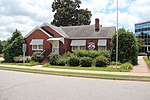West End Commercial Historic District (Greenville, South Carolina)
Commercial buildings on the National Register of Historic Places in South CarolinaHistoric districts in Greenville County, South CarolinaHistoric districts on the National Register of Historic Places in South CarolinaNRHP infobox with nocatNational Register of Historic Places in Greenville, South Carolina ... and 3 more
Upstate South Carolina Registered Historic Place stubsUse mdy dates from August 2023Victorian architecture in South Carolina

West End Commercial Historic District is a national historic district located at Greenville, South Carolina. It encompasses 15 contributing buildings in Greenville's second "downtown." The commercial buildings primarily date from about 1880 to 1920, and include examples of Victorian commercial architecture. Notable buildings include the American Bank, Alliance and Mills & McBayer Cotton Warehouses, Indian River Fruit Store, Pete's Place, Bacot's West End Drug Store/Stringer's Drug, Furman Lunch, and Greer Thompson Building.It was added to the National Register of Historic Places in 1993, with a boundary increase in 1998.
Excerpt from the Wikipedia article West End Commercial Historic District (Greenville, South Carolina) (License: CC BY-SA 3.0, Authors, Images).West End Commercial Historic District (Greenville, South Carolina)
South Main Street, Greenville Downtown
Geographical coordinates (GPS) Address Nearby Places Show on map
Geographical coordinates (GPS)
| Latitude | Longitude |
|---|---|
| N 34.844444444444 ° | E -82.404444444444 ° |
Address
South Main Street 701
29601 Greenville, Downtown
South Carolina, United States
Open on Google Maps









